MEXICAN MODERN ART ACCORDING TO NELKEN AND THE BLAISTEN COLLECTION
Fundación Casa de Mexico in Spain hosts the exhibition Modern Art of Mexico, with funds from the Blaisten Collection and curated by Daniel Garza Usabiaga, which takes an interesting look at the country's 20th century production through the eyes of Margarita Nelken (Madrid, Spain, 1894-Mexico City, Mexico, 1968).
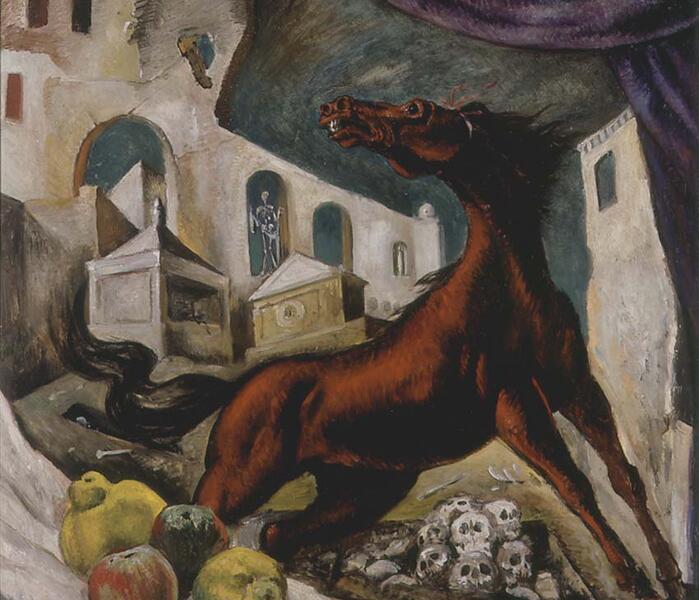
The Spanish intellectual exiled in Mexico, who serves as a cicerone almost as a curatorial or thesis thread, was one of the agents that most enriched criticism and artistic debate in the Mexican panorama. The relationship between the Spanish author and the collector arises from the study of the artistic practices of the first half of the 20th century that took place on the margins of muralism in Mexico. Her critical texts and commissioned works raised the discipline of historiography and the way of valuing new criteria of a local, almost anthropological nature.
In Arte Moderno de México, 64 paintings and sculptures from the collection can be seen, emphasizing the patrimonial importance of the most relevant names in the history of art, from Diego Rivera, Saturnino Herrán, Dr. Atl, Alfaro Siqueiros and Rufino Tamayo to José Clemente Orozco, María Izquierdo or José Guadalupe Posada, among others.
Her criticism of the institutionalization of certain styles, her perception of aesthetic progression and her support for the visibility of women artists are the fundamental lines that Nelken gave Garza Usabiaga for the creation of an exhibition that brings together disparate styles, local links and references, and historical themes for a show that also covers the chronology of that relationship and the development of modern art in Mexico from the 1940s until Nelken's death in 1968.
Modern Art from Mexico. Blaisten Collection can be seen until February 16, 2025 at Fundación Casa de México en España, Alberto Aguilera, 20, Madrid (Spain).
Related Topics
May interest you
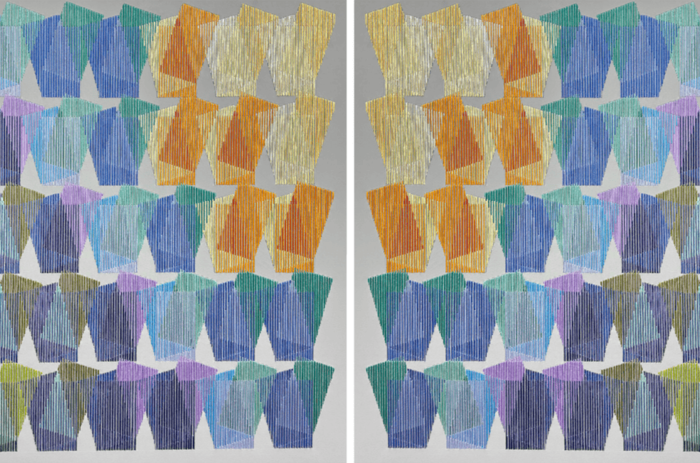
Isabella Despujols (Barquisemeto, Venezuela, 1994), Venezuelan artist based in Brazil, uses her artistic references for the realization of her latest series of works, a set made this year where textiles and embroidery are especially relevant, as well as the formal fact that they reflect. In them is palpable the conversation that he intends to maintain with those styles and languages that were fundamental in the countries to which he circumscribes his personal experience.
DESPUJOLS' EMBROIDERED GEOMETRY AT LLAMAZARES
Isabella Despujols (Barquisemeto, Venezuela, 1994), Venezuelan artist based in Brazil, uses her artistic references for the realization of her latest series of works, a set made this year where textiles and embroidery are especially relevant, as well as the formal fact that they reflect. In them is palpable the conversation that he intends to maintain with those styles and languages that were fundamental in the countries to which he circumscribes his personal experience.

Isabella Despujols (Barquisemeto, Venezuela, 1994), Venezuelan artist based in Brazil, uses her artistic references for the realization of her latest series of works, a set made this year where textiles and embroidery are especially relevant, as well as the formal fact that they reflect. In them is palpable the conversation that he intends to maintain with those styles and languages that were fundamental in the countries to which he circumscribes his personal experience.
DESPUJOLS' EMBROIDERED GEOMETRY AT LLAMAZARES
Isabella Despujols (Barquisemeto, Venezuela, 1994), Venezuelan artist based in Brazil, uses her artistic references for the realization of her latest series of works, a set made this year where textiles and embroidery are especially relevant, as well as the formal fact that they reflect. In them is palpable the conversation that he intends to maintain with those styles and languages that were fundamental in the countries to which he circumscribes his personal experience.

Based on the biologicist theories on territoriality and the relationships derived from living beings with their immediate environment, the Angeles Baños gallery from Badajoz proposes an exhibition project to three Latin American artists so that, through their experiences and their personal vision, they can materialize and express those feelings of territoriality, and always from the parallelism of the human being with the rest of living beings.
THE TERRITORIAL BY THREE LATIN AMERICAN ARTISTS AT ÁNGELES BAÑOS
Based on the biologicist theories on territoriality and the relationships derived from living beings with their immediate environment, the Angeles Baños gallery from Badajoz proposes an exhibition project to three Latin American artists so that, through their experiences and their personal vision, they can materialize and express those feelings of territoriality, and always from the parallelism of the human being with the rest of living beings.
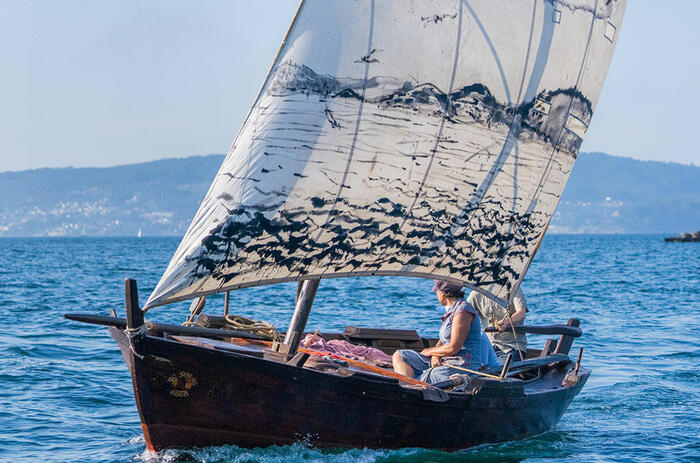
The Museum of Pontevedra exhibits Vento (wind, in Galician), the proposal that the artist Alberto Baraya (Bogota, Colombia, 1968) has developed and now shows at its headquarters in the Castelao Building as part of the cycle of exhibitions Infiltracións. This program aims to carry out specific projects that have as their backbone the dialogue arising from research and work with pieces from the collection of the Galician institution to promote re-readings on it.
VENTO BY ALBERTO BARAYA – IN PONTEVEDRA
The Museum of Pontevedra exhibits Vento (wind, in Galician), the proposal that the artist Alberto Baraya (Bogota, Colombia, 1968) has developed and now shows at its headquarters in the Castelao Building as part of the cycle of exhibitions Infiltracións. This program aims to carry out specific projects that have as their backbone the dialogue arising from research and work with pieces from the collection of the Galician institution to promote re-readings on it.
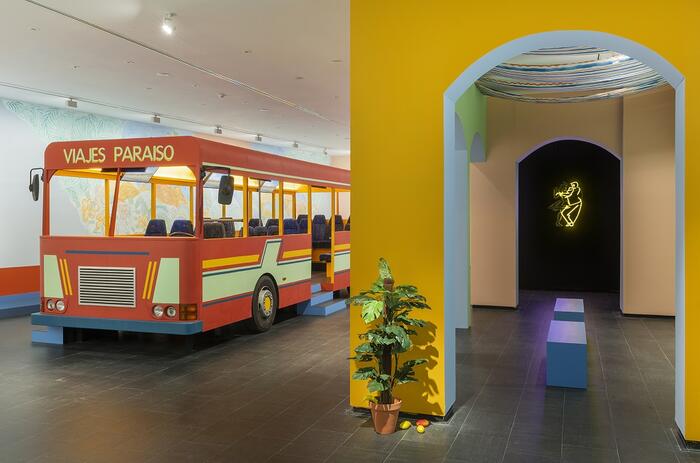
Sol Calero (Caracas, Venezuela, 1982) uses the guanabana, a fruit endemic to Central America and the Caribbean, to symbolically instrumentalize the creation of a representation of the feelings of belonging, home, everyday life and stereotypes through the wide conquest of the spaces of the Museo Centro de Arte Dos de Mayo, transformed for the occasion into visual and popular references of a well-known and recognized Latin America.
IDENTITY AND HOME – ACCORDING TO SOL CALERO IN THE CA2M MUSEUM
Sol Calero (Caracas, Venezuela, 1982) uses the guanabana, a fruit endemic to Central America and the Caribbean, to symbolically instrumentalize the creation of a representation of the feelings of belonging, home, everyday life and stereotypes through the wide conquest of the spaces of the Museo Centro de Arte Dos de Mayo, transformed for the occasion into visual and popular references of a well-known and recognized Latin America.
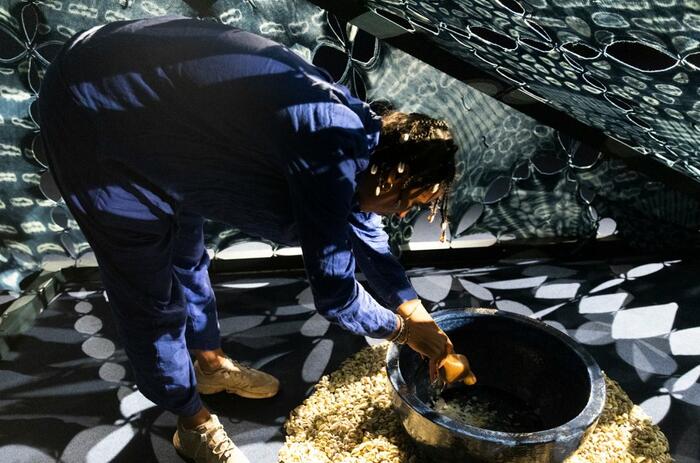
Nebulosa de la calabaza is the title of the first solo exhibition presented in Spain by Tabita Rezaire (Paris, France, 1989), an artist living in French Guiana. Renowned for her use of new media and multidisciplinarity to explore the relationship between contemporary worlds transited from technology and their relationship with the most ancestral and spiritual environment, the Guyanese-heritage artist focuses her production on activism from the perspective of denunciation from feminism and decolonization as key points.
DENOUNCEMENT AND ORIGIN IN TABITA REZAIRE
Nebulosa de la calabaza is the title of the first solo exhibition presented in Spain by Tabita Rezaire (Paris, France, 1989), an artist living in French Guiana. Renowned for her use of new media and multidisciplinarity to explore the relationship between contemporary worlds transited from technology and their relationship with the most ancestral and spiritual environment, the Guyanese-heritage artist focuses her production on activism from the perspective of denunciation from feminism and decolonization as key points.

The Studiotopia international program is open for the submission of proposals to the residency program for young scientists or emerging artists. LABoral Centro de Arte y Creación Industrial -in collaboration with other institutions- announces an international call for non-Spanish artists. Deadline to apply: November 7, 2024.
SCIENCE & ART: STUDIOTOPIA INTERNATIONAL OPEN CALL
The Studiotopia international program is open for the submission of proposals to the residency program for young scientists or emerging artists. LABoral Centro de Arte y Creación Industrial -in collaboration with other institutions- announces an international call for non-Spanish artists. Deadline to apply: November 7, 2024.
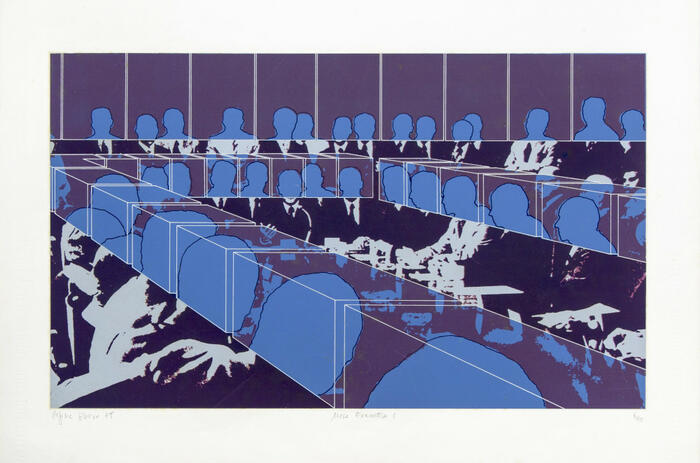
Barcelona's Center of Image La Virreina (La Virreina Centre de la Imatge) is dedicating an extensive exhibition to Regina Silveira (Porto Alegre, Brazil, 1939), one of the multimedia artists and key figures of Latin American conceptual art. Within the exhibition line of the center, which advocates the exploration of the aesthetic and ideological languages of images, this show curated by Isabella Lenzi covers a wide range of the Brazilian artist's research, experimentation and artistic production, particularly that developed with technical reproduction techniques and the circulation of images.
REGINA SILVEIRA'S DESTRUCTION OF POWER
Barcelona's Center of Image La Virreina (La Virreina Centre de la Imatge) is dedicating an extensive exhibition to Regina Silveira (Porto Alegre, Brazil, 1939), one of the multimedia artists and key figures of Latin American conceptual art. Within the exhibition line of the center, which advocates the exploration of the aesthetic and ideological languages of images, this show curated by Isabella Lenzi covers a wide range of the Brazilian artist's research, experimentation and artistic production, particularly that developed with technical reproduction techniques and the circulation of images.

Isabella Despujols (Barquisemeto, Venezuela, 1994), Venezuelan artist based in Brazil, uses her artistic references for the realization of her latest series of works, a set made this year where textiles and embroidery are especially relevant, as well as the formal fact that they reflect. In them is palpable the conversation that he intends to maintain with those styles and languages that were fundamental in the countries to which he circumscribes his personal experience.
DESPUJOLS' EMBROIDERED GEOMETRY AT LLAMAZARES
Isabella Despujols (Barquisemeto, Venezuela, 1994), Venezuelan artist based in Brazil, uses her artistic references for the realization of her latest series of works, a set made this year where textiles and embroidery are especially relevant, as well as the formal fact that they reflect. In them is palpable the conversation that he intends to maintain with those styles and languages that were fundamental in the countries to which he circumscribes his personal experience.

Based on the biologicist theories on territoriality and the relationships derived from living beings with their immediate environment, the Angeles Baños gallery from Badajoz proposes an exhibition project to three Latin American artists so that, through their experiences and their personal vision, they can materialize and express those feelings of territoriality, and always from the parallelism of the human being with the rest of living beings.
THE TERRITORIAL BY THREE LATIN AMERICAN ARTISTS AT ÁNGELES BAÑOS
Based on the biologicist theories on territoriality and the relationships derived from living beings with their immediate environment, the Angeles Baños gallery from Badajoz proposes an exhibition project to three Latin American artists so that, through their experiences and their personal vision, they can materialize and express those feelings of territoriality, and always from the parallelism of the human being with the rest of living beings.

The Museum of Pontevedra exhibits Vento (wind, in Galician), the proposal that the artist Alberto Baraya (Bogota, Colombia, 1968) has developed and now shows at its headquarters in the Castelao Building as part of the cycle of exhibitions Infiltracións. This program aims to carry out specific projects that have as their backbone the dialogue arising from research and work with pieces from the collection of the Galician institution to promote re-readings on it.
VENTO BY ALBERTO BARAYA – IN PONTEVEDRA
The Museum of Pontevedra exhibits Vento (wind, in Galician), the proposal that the artist Alberto Baraya (Bogota, Colombia, 1968) has developed and now shows at its headquarters in the Castelao Building as part of the cycle of exhibitions Infiltracións. This program aims to carry out specific projects that have as their backbone the dialogue arising from research and work with pieces from the collection of the Galician institution to promote re-readings on it.

Sol Calero (Caracas, Venezuela, 1982) uses the guanabana, a fruit endemic to Central America and the Caribbean, to symbolically instrumentalize the creation of a representation of the feelings of belonging, home, everyday life and stereotypes through the wide conquest of the spaces of the Museo Centro de Arte Dos de Mayo, transformed for the occasion into visual and popular references of a well-known and recognized Latin America.
IDENTITY AND HOME – ACCORDING TO SOL CALERO IN THE CA2M MUSEUM
Sol Calero (Caracas, Venezuela, 1982) uses the guanabana, a fruit endemic to Central America and the Caribbean, to symbolically instrumentalize the creation of a representation of the feelings of belonging, home, everyday life and stereotypes through the wide conquest of the spaces of the Museo Centro de Arte Dos de Mayo, transformed for the occasion into visual and popular references of a well-known and recognized Latin America.

Nebulosa de la calabaza is the title of the first solo exhibition presented in Spain by Tabita Rezaire (Paris, France, 1989), an artist living in French Guiana. Renowned for her use of new media and multidisciplinarity to explore the relationship between contemporary worlds transited from technology and their relationship with the most ancestral and spiritual environment, the Guyanese-heritage artist focuses her production on activism from the perspective of denunciation from feminism and decolonization as key points.
DENOUNCEMENT AND ORIGIN IN TABITA REZAIRE
Nebulosa de la calabaza is the title of the first solo exhibition presented in Spain by Tabita Rezaire (Paris, France, 1989), an artist living in French Guiana. Renowned for her use of new media and multidisciplinarity to explore the relationship between contemporary worlds transited from technology and their relationship with the most ancestral and spiritual environment, the Guyanese-heritage artist focuses her production on activism from the perspective of denunciation from feminism and decolonization as key points.

The Studiotopia international program is open for the submission of proposals to the residency program for young scientists or emerging artists. LABoral Centro de Arte y Creación Industrial -in collaboration with other institutions- announces an international call for non-Spanish artists. Deadline to apply: November 7, 2024.
SCIENCE & ART: STUDIOTOPIA INTERNATIONAL OPEN CALL
The Studiotopia international program is open for the submission of proposals to the residency program for young scientists or emerging artists. LABoral Centro de Arte y Creación Industrial -in collaboration with other institutions- announces an international call for non-Spanish artists. Deadline to apply: November 7, 2024.

Barcelona's Center of Image La Virreina (La Virreina Centre de la Imatge) is dedicating an extensive exhibition to Regina Silveira (Porto Alegre, Brazil, 1939), one of the multimedia artists and key figures of Latin American conceptual art. Within the exhibition line of the center, which advocates the exploration of the aesthetic and ideological languages of images, this show curated by Isabella Lenzi covers a wide range of the Brazilian artist's research, experimentation and artistic production, particularly that developed with technical reproduction techniques and the circulation of images.
REGINA SILVEIRA'S DESTRUCTION OF POWER
Barcelona's Center of Image La Virreina (La Virreina Centre de la Imatge) is dedicating an extensive exhibition to Regina Silveira (Porto Alegre, Brazil, 1939), one of the multimedia artists and key figures of Latin American conceptual art. Within the exhibition line of the center, which advocates the exploration of the aesthetic and ideological languages of images, this show curated by Isabella Lenzi covers a wide range of the Brazilian artist's research, experimentation and artistic production, particularly that developed with technical reproduction techniques and the circulation of images.

Isabella Despujols (Barquisemeto, Venezuela, 1994), Venezuelan artist based in Brazil, uses her artistic references for the realization of her latest series of works, a set made this year where textiles and embroidery are especially relevant, as well as the formal fact that they reflect. In them is palpable the conversation that he intends to maintain with those styles and languages that were fundamental in the countries to which he circumscribes his personal experience.
DESPUJOLS' EMBROIDERED GEOMETRY AT LLAMAZARES
Isabella Despujols (Barquisemeto, Venezuela, 1994), Venezuelan artist based in Brazil, uses her artistic references for the realization of her latest series of works, a set made this year where textiles and embroidery are especially relevant, as well as the formal fact that they reflect. In them is palpable the conversation that he intends to maintain with those styles and languages that were fundamental in the countries to which he circumscribes his personal experience.

Based on the biologicist theories on territoriality and the relationships derived from living beings with their immediate environment, the Angeles Baños gallery from Badajoz proposes an exhibition project to three Latin American artists so that, through their experiences and their personal vision, they can materialize and express those feelings of territoriality, and always from the parallelism of the human being with the rest of living beings.
THE TERRITORIAL BY THREE LATIN AMERICAN ARTISTS AT ÁNGELES BAÑOS
Based on the biologicist theories on territoriality and the relationships derived from living beings with their immediate environment, the Angeles Baños gallery from Badajoz proposes an exhibition project to three Latin American artists so that, through their experiences and their personal vision, they can materialize and express those feelings of territoriality, and always from the parallelism of the human being with the rest of living beings.

The Museum of Pontevedra exhibits Vento (wind, in Galician), the proposal that the artist Alberto Baraya (Bogota, Colombia, 1968) has developed and now shows at its headquarters in the Castelao Building as part of the cycle of exhibitions Infiltracións. This program aims to carry out specific projects that have as their backbone the dialogue arising from research and work with pieces from the collection of the Galician institution to promote re-readings on it.
VENTO BY ALBERTO BARAYA – IN PONTEVEDRA
The Museum of Pontevedra exhibits Vento (wind, in Galician), the proposal that the artist Alberto Baraya (Bogota, Colombia, 1968) has developed and now shows at its headquarters in the Castelao Building as part of the cycle of exhibitions Infiltracións. This program aims to carry out specific projects that have as their backbone the dialogue arising from research and work with pieces from the collection of the Galician institution to promote re-readings on it.

Sol Calero (Caracas, Venezuela, 1982) uses the guanabana, a fruit endemic to Central America and the Caribbean, to symbolically instrumentalize the creation of a representation of the feelings of belonging, home, everyday life and stereotypes through the wide conquest of the spaces of the Museo Centro de Arte Dos de Mayo, transformed for the occasion into visual and popular references of a well-known and recognized Latin America.
IDENTITY AND HOME – ACCORDING TO SOL CALERO IN THE CA2M MUSEUM
Sol Calero (Caracas, Venezuela, 1982) uses the guanabana, a fruit endemic to Central America and the Caribbean, to symbolically instrumentalize the creation of a representation of the feelings of belonging, home, everyday life and stereotypes through the wide conquest of the spaces of the Museo Centro de Arte Dos de Mayo, transformed for the occasion into visual and popular references of a well-known and recognized Latin America.

Nebulosa de la calabaza is the title of the first solo exhibition presented in Spain by Tabita Rezaire (Paris, France, 1989), an artist living in French Guiana. Renowned for her use of new media and multidisciplinarity to explore the relationship between contemporary worlds transited from technology and their relationship with the most ancestral and spiritual environment, the Guyanese-heritage artist focuses her production on activism from the perspective of denunciation from feminism and decolonization as key points.
DENOUNCEMENT AND ORIGIN IN TABITA REZAIRE
Nebulosa de la calabaza is the title of the first solo exhibition presented in Spain by Tabita Rezaire (Paris, France, 1989), an artist living in French Guiana. Renowned for her use of new media and multidisciplinarity to explore the relationship between contemporary worlds transited from technology and their relationship with the most ancestral and spiritual environment, the Guyanese-heritage artist focuses her production on activism from the perspective of denunciation from feminism and decolonization as key points.

The Studiotopia international program is open for the submission of proposals to the residency program for young scientists or emerging artists. LABoral Centro de Arte y Creación Industrial -in collaboration with other institutions- announces an international call for non-Spanish artists. Deadline to apply: November 7, 2024.
SCIENCE & ART: STUDIOTOPIA INTERNATIONAL OPEN CALL
The Studiotopia international program is open for the submission of proposals to the residency program for young scientists or emerging artists. LABoral Centro de Arte y Creación Industrial -in collaboration with other institutions- announces an international call for non-Spanish artists. Deadline to apply: November 7, 2024.

Barcelona's Center of Image La Virreina (La Virreina Centre de la Imatge) is dedicating an extensive exhibition to Regina Silveira (Porto Alegre, Brazil, 1939), one of the multimedia artists and key figures of Latin American conceptual art. Within the exhibition line of the center, which advocates the exploration of the aesthetic and ideological languages of images, this show curated by Isabella Lenzi covers a wide range of the Brazilian artist's research, experimentation and artistic production, particularly that developed with technical reproduction techniques and the circulation of images.
REGINA SILVEIRA'S DESTRUCTION OF POWER
Barcelona's Center of Image La Virreina (La Virreina Centre de la Imatge) is dedicating an extensive exhibition to Regina Silveira (Porto Alegre, Brazil, 1939), one of the multimedia artists and key figures of Latin American conceptual art. Within the exhibition line of the center, which advocates the exploration of the aesthetic and ideological languages of images, this show curated by Isabella Lenzi covers a wide range of the Brazilian artist's research, experimentation and artistic production, particularly that developed with technical reproduction techniques and the circulation of images.

Isabella Despujols (Barquisemeto, Venezuela, 1994), Venezuelan artist based in Brazil, uses her artistic references for the realization of her latest series of works, a set made this year where textiles and embroidery are especially relevant, as well as the formal fact that they reflect. In them is palpable the conversation that he intends to maintain with those styles and languages that were fundamental in the countries to which he circumscribes his personal experience.
DESPUJOLS' EMBROIDERED GEOMETRY AT LLAMAZARES
Isabella Despujols (Barquisemeto, Venezuela, 1994), Venezuelan artist based in Brazil, uses her artistic references for the realization of her latest series of works, a set made this year where textiles and embroidery are especially relevant, as well as the formal fact that they reflect. In them is palpable the conversation that he intends to maintain with those styles and languages that were fundamental in the countries to which he circumscribes his personal experience.

Based on the biologicist theories on territoriality and the relationships derived from living beings with their immediate environment, the Angeles Baños gallery from Badajoz proposes an exhibition project to three Latin American artists so that, through their experiences and their personal vision, they can materialize and express those feelings of territoriality, and always from the parallelism of the human being with the rest of living beings.
THE TERRITORIAL BY THREE LATIN AMERICAN ARTISTS AT ÁNGELES BAÑOS
Based on the biologicist theories on territoriality and the relationships derived from living beings with their immediate environment, the Angeles Baños gallery from Badajoz proposes an exhibition project to three Latin American artists so that, through their experiences and their personal vision, they can materialize and express those feelings of territoriality, and always from the parallelism of the human being with the rest of living beings.

The Museum of Pontevedra exhibits Vento (wind, in Galician), the proposal that the artist Alberto Baraya (Bogota, Colombia, 1968) has developed and now shows at its headquarters in the Castelao Building as part of the cycle of exhibitions Infiltracións. This program aims to carry out specific projects that have as their backbone the dialogue arising from research and work with pieces from the collection of the Galician institution to promote re-readings on it.
VENTO BY ALBERTO BARAYA – IN PONTEVEDRA
The Museum of Pontevedra exhibits Vento (wind, in Galician), the proposal that the artist Alberto Baraya (Bogota, Colombia, 1968) has developed and now shows at its headquarters in the Castelao Building as part of the cycle of exhibitions Infiltracións. This program aims to carry out specific projects that have as their backbone the dialogue arising from research and work with pieces from the collection of the Galician institution to promote re-readings on it.

Sol Calero (Caracas, Venezuela, 1982) uses the guanabana, a fruit endemic to Central America and the Caribbean, to symbolically instrumentalize the creation of a representation of the feelings of belonging, home, everyday life and stereotypes through the wide conquest of the spaces of the Museo Centro de Arte Dos de Mayo, transformed for the occasion into visual and popular references of a well-known and recognized Latin America.
IDENTITY AND HOME – ACCORDING TO SOL CALERO IN THE CA2M MUSEUM
Sol Calero (Caracas, Venezuela, 1982) uses the guanabana, a fruit endemic to Central America and the Caribbean, to symbolically instrumentalize the creation of a representation of the feelings of belonging, home, everyday life and stereotypes through the wide conquest of the spaces of the Museo Centro de Arte Dos de Mayo, transformed for the occasion into visual and popular references of a well-known and recognized Latin America.

Nebulosa de la calabaza is the title of the first solo exhibition presented in Spain by Tabita Rezaire (Paris, France, 1989), an artist living in French Guiana. Renowned for her use of new media and multidisciplinarity to explore the relationship between contemporary worlds transited from technology and their relationship with the most ancestral and spiritual environment, the Guyanese-heritage artist focuses her production on activism from the perspective of denunciation from feminism and decolonization as key points.
DENOUNCEMENT AND ORIGIN IN TABITA REZAIRE
Nebulosa de la calabaza is the title of the first solo exhibition presented in Spain by Tabita Rezaire (Paris, France, 1989), an artist living in French Guiana. Renowned for her use of new media and multidisciplinarity to explore the relationship between contemporary worlds transited from technology and their relationship with the most ancestral and spiritual environment, the Guyanese-heritage artist focuses her production on activism from the perspective of denunciation from feminism and decolonization as key points.

The Studiotopia international program is open for the submission of proposals to the residency program for young scientists or emerging artists. LABoral Centro de Arte y Creación Industrial -in collaboration with other institutions- announces an international call for non-Spanish artists. Deadline to apply: November 7, 2024.
SCIENCE & ART: STUDIOTOPIA INTERNATIONAL OPEN CALL
The Studiotopia international program is open for the submission of proposals to the residency program for young scientists or emerging artists. LABoral Centro de Arte y Creación Industrial -in collaboration with other institutions- announces an international call for non-Spanish artists. Deadline to apply: November 7, 2024.

Barcelona's Center of Image La Virreina (La Virreina Centre de la Imatge) is dedicating an extensive exhibition to Regina Silveira (Porto Alegre, Brazil, 1939), one of the multimedia artists and key figures of Latin American conceptual art. Within the exhibition line of the center, which advocates the exploration of the aesthetic and ideological languages of images, this show curated by Isabella Lenzi covers a wide range of the Brazilian artist's research, experimentation and artistic production, particularly that developed with technical reproduction techniques and the circulation of images.
REGINA SILVEIRA'S DESTRUCTION OF POWER
Barcelona's Center of Image La Virreina (La Virreina Centre de la Imatge) is dedicating an extensive exhibition to Regina Silveira (Porto Alegre, Brazil, 1939), one of the multimedia artists and key figures of Latin American conceptual art. Within the exhibition line of the center, which advocates the exploration of the aesthetic and ideological languages of images, this show curated by Isabella Lenzi covers a wide range of the Brazilian artist's research, experimentation and artistic production, particularly that developed with technical reproduction techniques and the circulation of images.

Isabella Despujols (Barquisemeto, Venezuela, 1994), Venezuelan artist based in Brazil, uses her artistic references for the realization of her latest series of works, a set made this year where textiles and embroidery are especially relevant, as well as the formal fact that they reflect. In them is palpable the conversation that he intends to maintain with those styles and languages that were fundamental in the countries to which he circumscribes his personal experience.
DESPUJOLS' EMBROIDERED GEOMETRY AT LLAMAZARES
Isabella Despujols (Barquisemeto, Venezuela, 1994), Venezuelan artist based in Brazil, uses her artistic references for the realization of her latest series of works, a set made this year where textiles and embroidery are especially relevant, as well as the formal fact that they reflect. In them is palpable the conversation that he intends to maintain with those styles and languages that were fundamental in the countries to which he circumscribes his personal experience.

Based on the biologicist theories on territoriality and the relationships derived from living beings with their immediate environment, the Angeles Baños gallery from Badajoz proposes an exhibition project to three Latin American artists so that, through their experiences and their personal vision, they can materialize and express those feelings of territoriality, and always from the parallelism of the human being with the rest of living beings.
THE TERRITORIAL BY THREE LATIN AMERICAN ARTISTS AT ÁNGELES BAÑOS
Based on the biologicist theories on territoriality and the relationships derived from living beings with their immediate environment, the Angeles Baños gallery from Badajoz proposes an exhibition project to three Latin American artists so that, through their experiences and their personal vision, they can materialize and express those feelings of territoriality, and always from the parallelism of the human being with the rest of living beings.

The Museum of Pontevedra exhibits Vento (wind, in Galician), the proposal that the artist Alberto Baraya (Bogota, Colombia, 1968) has developed and now shows at its headquarters in the Castelao Building as part of the cycle of exhibitions Infiltracións. This program aims to carry out specific projects that have as their backbone the dialogue arising from research and work with pieces from the collection of the Galician institution to promote re-readings on it.
VENTO BY ALBERTO BARAYA – IN PONTEVEDRA
The Museum of Pontevedra exhibits Vento (wind, in Galician), the proposal that the artist Alberto Baraya (Bogota, Colombia, 1968) has developed and now shows at its headquarters in the Castelao Building as part of the cycle of exhibitions Infiltracións. This program aims to carry out specific projects that have as their backbone the dialogue arising from research and work with pieces from the collection of the Galician institution to promote re-readings on it.

Sol Calero (Caracas, Venezuela, 1982) uses the guanabana, a fruit endemic to Central America and the Caribbean, to symbolically instrumentalize the creation of a representation of the feelings of belonging, home, everyday life and stereotypes through the wide conquest of the spaces of the Museo Centro de Arte Dos de Mayo, transformed for the occasion into visual and popular references of a well-known and recognized Latin America.
IDENTITY AND HOME – ACCORDING TO SOL CALERO IN THE CA2M MUSEUM
Sol Calero (Caracas, Venezuela, 1982) uses the guanabana, a fruit endemic to Central America and the Caribbean, to symbolically instrumentalize the creation of a representation of the feelings of belonging, home, everyday life and stereotypes through the wide conquest of the spaces of the Museo Centro de Arte Dos de Mayo, transformed for the occasion into visual and popular references of a well-known and recognized Latin America.

Nebulosa de la calabaza is the title of the first solo exhibition presented in Spain by Tabita Rezaire (Paris, France, 1989), an artist living in French Guiana. Renowned for her use of new media and multidisciplinarity to explore the relationship between contemporary worlds transited from technology and their relationship with the most ancestral and spiritual environment, the Guyanese-heritage artist focuses her production on activism from the perspective of denunciation from feminism and decolonization as key points.
DENOUNCEMENT AND ORIGIN IN TABITA REZAIRE
Nebulosa de la calabaza is the title of the first solo exhibition presented in Spain by Tabita Rezaire (Paris, France, 1989), an artist living in French Guiana. Renowned for her use of new media and multidisciplinarity to explore the relationship between contemporary worlds transited from technology and their relationship with the most ancestral and spiritual environment, the Guyanese-heritage artist focuses her production on activism from the perspective of denunciation from feminism and decolonization as key points.

The Studiotopia international program is open for the submission of proposals to the residency program for young scientists or emerging artists. LABoral Centro de Arte y Creación Industrial -in collaboration with other institutions- announces an international call for non-Spanish artists. Deadline to apply: November 7, 2024.
SCIENCE & ART: STUDIOTOPIA INTERNATIONAL OPEN CALL
The Studiotopia international program is open for the submission of proposals to the residency program for young scientists or emerging artists. LABoral Centro de Arte y Creación Industrial -in collaboration with other institutions- announces an international call for non-Spanish artists. Deadline to apply: November 7, 2024.

Barcelona's Center of Image La Virreina (La Virreina Centre de la Imatge) is dedicating an extensive exhibition to Regina Silveira (Porto Alegre, Brazil, 1939), one of the multimedia artists and key figures of Latin American conceptual art. Within the exhibition line of the center, which advocates the exploration of the aesthetic and ideological languages of images, this show curated by Isabella Lenzi covers a wide range of the Brazilian artist's research, experimentation and artistic production, particularly that developed with technical reproduction techniques and the circulation of images.
REGINA SILVEIRA'S DESTRUCTION OF POWER
Barcelona's Center of Image La Virreina (La Virreina Centre de la Imatge) is dedicating an extensive exhibition to Regina Silveira (Porto Alegre, Brazil, 1939), one of the multimedia artists and key figures of Latin American conceptual art. Within the exhibition line of the center, which advocates the exploration of the aesthetic and ideological languages of images, this show curated by Isabella Lenzi covers a wide range of the Brazilian artist's research, experimentation and artistic production, particularly that developed with technical reproduction techniques and the circulation of images.




